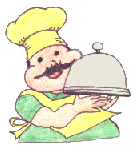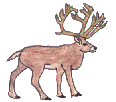
For the well-to-do, eating during the Elizabethan and Jacobean periods was a fancy affair. A king or queen when going abroad could expect banquet tables filled with hundreds of dishes--for just one meal! There was much pageantry and entertainment. At Leicester, Queen Elizabeth I (predecessor of King James VI & I) was greeted with a pageant of welcome displayed on a temporary bridge. There were cages of live birds--bitterns, curlews, hernshaws and godwits. One pillar held great silver bowls piled with apples, pears, cherries, walnuts and filberts. Other pillars held ears of wheat, oats and barley, gigantic bunches of red and white grapes, great livery pots of claret and white wine, sea fish in quantity laying upon fresh grass, and the last pillar was devoted to the arts. There were arms and music explained by a blue-clad poet.
The evenings were marked by entertainments of various sorts like a water pageant with a costumed actor riding in on a dolphin. The food was brought in thousands of crystal and silver dishes served by dozens, sometimes hundreds, of gentlemen. Rich Elizabethans dined twice a day--breakfast at eleven or twelve and supper between five and six.
Of course, the meals of the common man were not so extravagant. The common man ate three meals a day: breakfast in the early am, dinner at twelve and supper at six. The poorer sort, supped when they could. A poem by Thomas Tusser gives a good idea of the break fast of the typical farmer:
Call Servants to breakfast, by day star appear,
a snatch to wake fellows, but tarry not here.
Let Huswife be carver, let pottage be eat,
a dishful each one with a morsel of meat.
Rich Elizabethans loved hospitality and had chronic guests. In following the old custome, they gathered in the Great Hall where the host sat at the head of the table and guests were arranged in order of importance. Food was prepared in vast quantities and what was left over went to servants. After the servants ate, the remaining food was given to the poor who waited outside the rich men's gates--reminds one of Lazarus and the rich man.
 Kitchen Equipment:
brick ovens, working table, spits, pots, posnetts, chafing-dishes, graters, mortars and pestles, boilers, knives, cleavers axes, dripping-pans, pot-racks, pot-hooks, gridirons, frying pans, sieves, kneading troughs, fire shovels, barrels, tubs, pantry, buttery (wine and other provisions stored here), wet and dry larders, spicery, mealhouse sieving or bolting house, coals kep in squillerie along with brass pots and pans, pewter vessels and herbs, covered dishes, court cupboard, sideboards. Drinking vessels: gold, silver, pewter, horn, leather, glass, earthenware.
Kitchen Equipment:
brick ovens, working table, spits, pots, posnetts, chafing-dishes, graters, mortars and pestles, boilers, knives, cleavers axes, dripping-pans, pot-racks, pot-hooks, gridirons, frying pans, sieves, kneading troughs, fire shovels, barrels, tubs, pantry, buttery (wine and other provisions stored here), wet and dry larders, spicery, mealhouse sieving or bolting house, coals kep in squillerie along with brass pots and pans, pewter vessels and herbs, covered dishes, court cupboard, sideboards. Drinking vessels: gold, silver, pewter, horn, leather, glass, earthenware.
 Meat:
beef, mutton, lamb, veal, kid, port, coney, pig, venison, fish (sometimes salted--pike, salmon, haddock, gurnard, tench, sturgeon, conger-eels, carp, lampreys, chines of salmon, perch, white herring, shrimp, pilchards, mackerel, oysters),
sausage, eggs, sheep's feet, meat pies. Due to lack of refrigeration, techniques for preparing spoiled meat--vinegar, burying, sauces, spices. Cheese
Meat:
beef, mutton, lamb, veal, kid, port, coney, pig, venison, fish (sometimes salted--pike, salmon, haddock, gurnard, tench, sturgeon, conger-eels, carp, lampreys, chines of salmon, perch, white herring, shrimp, pilchards, mackerel, oysters),
sausage, eggs, sheep's feet, meat pies. Due to lack of refrigeration, techniques for preparing spoiled meat--vinegar, burying, sauces, spices. Cheese
 Fowl
domestic and wild--crane, bitter, swan, brant, lark, plover, quail, teal, widgeon, mallard, shelldrake, shoveller, peewit, scamen, knot, olicet, dun bird, partridge, pheasant, sparrows, doves, pigeons, cocks, hens, geese, ducks, peacocks of the Ind, turkeys, pelican, blackbirds,.
Fowl
domestic and wild--crane, bitter, swan, brant, lark, plover, quail, teal, widgeon, mallard, shelldrake, shoveller, peewit, scamen, knot, olicet, dun bird, partridge, pheasant, sparrows, doves, pigeons, cocks, hens, geese, ducks, peacocks of the Ind, turkeys, pelican, blackbirds,.
 Vegetables
beans, turnips, greens, parsnips, carrots, cabbage, colewart, beetroot, salsify, artichokes, asparagus, peas, salads, lettuce, onions, leeks, pumpkins, melon, cucumbers, skirret, horseradish, gourds, olives, potatoes, yams. Herbs: chervil, young sow thistle, corn salad, leaves of clary, spotted cowslip.
Vegetables
beans, turnips, greens, parsnips, carrots, cabbage, colewart, beetroot, salsify, artichokes, asparagus, peas, salads, lettuce, onions, leeks, pumpkins, melon, cucumbers, skirret, horseradish, gourds, olives, potatoes, yams. Herbs: chervil, young sow thistle, corn salad, leaves of clary, spotted cowslip.
 Bread
wheat, white, rye, barley. In times of dearth bread made of horse-corn, peas, beans, oats, tares, lentils, acorns.
Bread
wheat, white, rye, barley. In times of dearth bread made of horse-corn, peas, beans, oats, tares, lentils, acorns.
 Fruit
oranges, cherries, rasberries, strawberries, mulberries, peaches, apricots, cornels, currants, raisins, lemons, gooseberry, plums, pears, apples, grapes.
Fruit
oranges, cherries, rasberries, strawberries, mulberries, peaches, apricots, cornels, currants, raisins, lemons, gooseberry, plums, pears, apples, grapes.
 Sweets
custard, jellies, eringoes, comfits, suckets, codinac, marmalade, cakes, pastries, sugar bread, gingerbread, flan, seed cake, pudding, mincepies, sugar, honey.
Sweets
custard, jellies, eringoes, comfits, suckets, codinac, marmalade, cakes, pastries, sugar bread, gingerbread, flan, seed cake, pudding, mincepies, sugar, honey.
 Drinks stale ale, spirits, milk, buttermilk, whey. Tea and coffee were unknown until well into the 1600s.
Drinks stale ale, spirits, milk, buttermilk, whey. Tea and coffee were unknown until well into the 1600s.
Back to His Majesty's Home Page
Many thanks to Orchid for the gorgeous graphics!